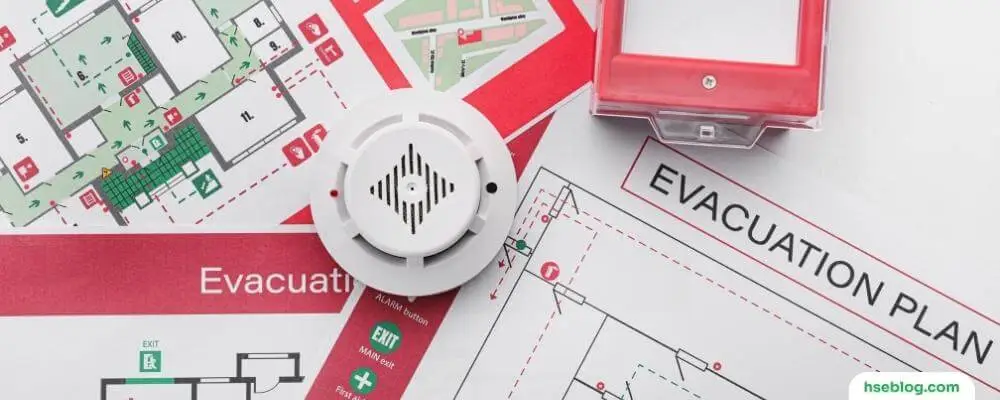Emergency Action Plan (EAP) | Definition & 10 Key Elements

An Emergency Action Plan (EAP) is a critical component of any workplace safety program designed to keep employees safe during an emergency. An effective EAP can mitigate risk, reduce injuries, and even save lives, whether a natural disaster, fire, chemical spill, or any other unforeseen event. But what does an effective EAP look like, and what components should it contain?
This blog post will delve deep into an Emergency Action Plan concept. We’ll start by defining exactly what an EAP is. Then we’ll move on to discuss its 10 key elements: Evacuation Procedures, Emergency Escape Procedures, Route Assignments, Procedures for Employees who Assist in Evacuation, Accounting for all Employees After Evacuation, Rescue and Medical Duties, Alarm System, Communication and Coordination, Training, Review and Updates, and Contact Information.
Understanding these components is the first step in developing an EAP for your organization or refining and improving your plan. So, let’s get started and ensure that your workplace is prepared for any emergency situation that may arise.

10 Key Elements In The Emergency Action Plan (EAP)
An Emergency Action Plan (EAP) is a written document required by certain OSHA standards. It facilitates and organizes employer and employee actions during workplace emergencies. The objective of an EAP is to provide a comprehensive strategy that prepares businesses or organizations to respond quickly and effectively in an emergency, minimizing potential injuries, property damage, and downtime.
The EAP can be tailored to a workplace’s specific needs and conditions. However, there are certain key elements that every EAP should include:
1. Evacuation Procedures
The Evacuation Procedures section of the Emergency Action Plan (EAP) is a vital component that dictates how employees should exit the workplace in the case of an emergency. This is usually the first response in many emergency situations. This component must be thorough, clear, and precise to ensure safety.
Here are the key aspects to consider in more detail:
- Evacuation routes and exits: The EAP should clearly mark all the primary and secondary evacuation routes. These routes should be free of obstructions, well-lit, and wide enough to accommodate the rush of employees during an emergency. Exit doors should be clearly marked, easily accessible, and never locked or blocked. Secondary routes are also crucial if the primary route is blocked or dangerous.
- Assembly Points: Post-evacuation, employees need to gather at predesignated assembly points. These locations should be safe from the building to avoid potential hazards from the emergency and large enough to accommodate all employees. This is also where a roll call would typically take place.
- Designated Authorities: The EAP should specify who can order an evacuation. This is typically a manager or safety officer, but it can be anyone the company assigns. These individuals are responsible for recognizing when an evacuation needs to occur and initiating the evacuation process.
- Evacuation Conditions: The EAP should define the types of emergencies that necessitate evacuation. These might include fires, natural disasters, gas leaks, chemical spills, or bomb threats.
- Special Needs Employees: The plan should also consider employees with disabilities or special needs. Provisions should be made to ensure their safe and timely evacuation.
- Communication During Evacuation: Clear guidelines must be provided on how communication should be carried out during an evacuation – for instance, verbal instructions, alarms, or intercom announcements.
- Evacuation Drills: Regularly scheduled drills should be held to ensure all employees are familiar with the evacuation procedures. This helps employees understand the plan better and offers an opportunity to test the viability of the evacuation routes and assembly points.
Remember, the Evacuation Procedures section of the EAP aims to ensure everyone knows what to do, where to go, and how to get there safely in the event of an emergency. Hence, this part of the EAP must be communicated effectively and regularly reviewed.
2. Emergency Escape Procedures and Route Assignments
Emergency Escape Procedures and Route Assignments are critical to an Emergency Action Plan (EAP). They provide an organized and clear path for employees to follow when an emergency evacuation is necessary. Here’s a detailed breakdown of this section:
- Floor Plans and Workplace Maps: A well-drawn and precise floor plan or map should be incorporated into the EAP. It should clearly indicate the current location, the escape routes, exits, stairwells, elevators (though these are typically not to be used during emergencies), and safe assembly points outside the building. The maps should be easily read and posted in various conspicuous locations throughout the workplace, such as near stairwells, elevators, and main entrances/exits.
- Route Assignments: The EAP should assign specific evacuation routes to groups of employees or departments to avoid confusion and congestion. Both primary and secondary routes should be assigned if the primary route is blocked or unsafe. The route assignment should consider the physical capabilities of employees, the locations of the exits, and the type of emergency.
- Employees Operating Critical Operations: Some employees may be required to stay behind briefly to shut down critical equipment, close fire doors, or perform other essential tasks before evacuating. The EAP should specify who these employees are, their tasks, and how they should eventually evacuate. Their safety is paramount, and these procedures should be designed such that their stay does not put them at greater risk.
- Procedures for Mobility-Impaired Employees: The EAP should detail the procedures and provisions to help mobility-impaired employees or anyone with disabilities evacuate. This could include assigning specific personnel to assist these individuals.
- Drills and Training: All employees should participate in regular drills to practice the escape procedures and route assignments. This helps them remember the routes and procedures and allows for evaluation and refinement of the plans based on real-time experience. Training should also include responding to different emergencies requiring different escape procedures.
- Updates to Escape Procedures and Route Assignments: As businesses grow and evolve, changes in infrastructure, employee roles, and other factors can impact the relevance and effectiveness of existing escape procedures and route assignments. Regularly reviewing and updating these components of the EAP as necessary is crucial to maintain their efficacy.
Remember, the ultimate goal of the Emergency Escape Procedures and Route Assignments is to ensure a smooth, efficient, and safe evacuation of all employees during an emergency. They must be well-planned, clearly communicated, regularly practiced, and updated as needed.

3. Procedures for employees who assist in the evacuation
Designating certain employees to assist in evacuation is a crucial part of an Emergency Action Plan (EAP). These employees play a key role in ensuring a smooth, organized, and efficient evacuation in an emergency. Let’s dive deeper into the details of this aspect of the EAP:
Designation of Evacuation Wardens
A company should designate and train specific employees, often known as evacuation wardens or marshals, to assist in the event of an evacuation. The number of evacuation wardens would typically depend on the size and complexity of the workplace. A general rule is to have one warden for every 20 employees.
Roles and Responsibilities of Evacuation Wardens
The primary role of evacuation wardens is to guide and assist other employees during an evacuation. Their responsibilities may include:
- Ensuring all employees are aware of the evacuation order.
- Directing employees towards safe evacuation routes.
- Checking areas (offices, bathrooms, meeting rooms) to ensure everyone has evacuated.
- Assisting with evacuating individuals with special needs or requiring extra help.
- Reporting to the incident command post or assembly point to confirm that all individuals are out of the building.
Training for Evacuation Wardens
These designated employees should receive specialized training. This training should cover details of the EAP, their roles and responsibilities, methods of clear and effective communication during an emergency, and how to assist individuals with special needs. They should also be trained in basic first aid and fire safety.
Special Equipment
If necessary, evacuation wardens may receive special equipment such as high visibility vests, flashlights, whistles, or two-way radios to help fulfill their duties more effectively.
Alternate Evacuation Wardens
If the primary wardens are unavailable or unable to perform their duties, alternate wardens should be designated and trained to step in.
Participation in Drills
Evacuation wardens should regularly participate in evacuation drills to keep their skills sharp and stay familiar with the procedures.
By having designated and well-trained employees to assist with an evacuation, an organization can significantly enhance its emergency response’s effectiveness and help ensure all employees’ safety.
4. Accounting for all employees after evacuation
Accounting for all employees after an evacuation is integral to any Emergency Action Plan (EAP). This process helps ensure that everyone has safely exited the building and that no one is left behind in a potentially dangerous situation. Here’s a detailed look at what this involves:
- Assembly Points: The EAP should designate specific assembly points where employees should gather after evacuating the building. These points should be safe from the building and easily accessible from the evacuation routes.
- Roll Call or Check-In System: A roll call or check-in system should be implemented once at the assembly point. This could involve physically taking attendance, using a digital check-in on a mobile app, or even a simple headcount. Managers, supervisors, or designated evacuation wardens could be responsible for accounting for their respective teams.
- Missing Employees: If any employees are unaccounted for, the person in charge of roll call should immediately notify the emergency services personnel on-site. Under no circumstances should anyone re-enter the building to search for a missing person – that should be left to the trained professionals.
- Visitor Logs: Visitor logs should be maintained and checked during a roll call. If any visitors were in the building at the time of the evacuation, they, too, need to be accounted for.
- Communication Plan: A communication plan should be in place to update employees and relevant stakeholders about the situation. This could be a mass text messaging system, an email blast, or calls from a designated communication officer.
- Training: Employees should be trained on these procedures and should know who is responsible for accounting for their safety. The process should also be tested and practiced during evacuation drills.
- Updates to Accounting Procedures: Procedures should be reviewed regularly to account for changes in staff, building layout, technology, or any learnings from drills or actual emergencies.
Organizations can help ensure everyone’s safety and facilitate rescue efforts if anyone is missing by effectively accounting for all employees after an evacuation.

5. Rescue and Medical Duties
The Rescue and Medical Duties component of an Emergency Action Plan (EAP) is vital in ensuring that any individuals who are injured or unwell during an emergency get the care they need as swiftly as possible. Here’s a more detailed breakdown of this section:
- First Aid Providers: The EAP should designate individuals trained and certified in providing first aid. These individuals would administer initial medical care to those injured until professional medical help arrived.
- Medical Equipment: The EAP should also specify the location of first aid kits, defibrillators, or other medical equipment that might be needed in an emergency. Everyone in the workplace should be made aware of these locations.
- Rescue Duties: In some workplaces, there may be a need for specific rescue duties to be assigned. For example, in a mining or construction setting, there might be a need for a confined space rescue team. Any individuals designated for rescue duties should be fully trained, equipped with the necessary tools, and never put themselves in unnecessary danger.
- Emergency Contact Information: The EAP should include emergency contact numbers for local hospitals, clinics, poison control, etc. so that professional medical help can be contacted quickly.
- Training: Employees designated to perform rescue and medical duties should receive adequate training, which should be refreshed regularly. This training can include first aid, CPR, automated external defibrillator (AED) use, and any other specialized training relevant to the workplace.
- Communication: The EAP should specify who is responsible for contacting professional medical help in an emergency and the procedures they should follow.
- Critical Incident Stress Management: In the aftermath of an emergency, having resources in place to handle psychological trauma and stress management for affected employees can be beneficial.
Remember, the primary goal of rescue and medical duties is to provide immediate and effective care to injured individuals during an emergency, to minimize the impact of injuries, and to save lives. This component of the EAP needs to be implemented effectively and communicated to all employees.
6. Alarm System
The Alarm System component of an Emergency Action Plan (EAP) is crucial for alerting employees of an emergency situation and triggering the evacuation process. Here’s a more detailed explanation:
- Alarm Types: The EAP should detail what type of alarm system is in place. This could be auditory signals like sirens, buzzers, bells, or voice announcement systems; visual signals like flashing lights, particularly important in noisy environments or for hearing-impaired individuals; or digital alerts such as text messages, emails, or app notifications.
- Signal Recognition: The EAP should clarify how to recognize and interpret the different alarm signals. If there are different signals for different types of emergencies (like a fire, chemical spill, or intruder alert), these should be clearly explained to all employees.
- Reporting Emergencies: The EAP should also establish the procedure for reporting emergencies. Who should an employee contact if they discover a fire, smell gas, or notice a security breach? This might involve pulling a fire alarm, dialing a specific number, or notifying a supervisor or designated safety officer.
- Alarm Activation Procedures: Specific procedures should be in place for activating the alarm system, and designated individuals should be trained in these procedures.
- System Maintenance: Regular maintenance checks and tests of the alarm system are essential to ensure its reliability and effectiveness.
- Training: Regular employee training is crucial to ensure everyone understands how to report emergencies, recognize different alarms, and what actions to take when an alarm sounds.
- Communication Systems: In large organizations, there may be other communication systems in place, such as public address systems or two-way radios, for providing real-time updates or instructions during an emergency.
Remember, the alarm system is usually the first indication of an emergency for most employees, so its importance can’t be overstated. It needs to be reliable, understood by everyone, and regularly tested.

7. Communication and Coordination
The Communication and Coordination section of an Emergency Action Plan (EAP) ensures that the right people are in charge during an emergency. That information is effectively communicated between everyone involved, including employees, first responders, and other stakeholders. Let’s break this down into more detail:
- Designated Coordinators/Leaders: The EAP should designate certain individuals as emergency coordinators or leaders. These individuals are in charge of implementing the EAP during an emergency. This role may involve coordinating the evacuation, accounting for all employees, or communicating with first responders.
- Roles and Responsibilities: The roles and responsibilities of these leaders should be clearly outlined in the EAP. This can include actions to be taken during the emergency, responsibilities for ensuring communication between all parties, and tasks to be completed post-emergency, like reviewing and improving the EAP based on the experience.
- Communication with Employees: Clear, effective communication is key during an emergency. The EAP should outline how the information will be relayed to employees – this could be through alarms, PA systems, or digital communications. This should also include how to communicate changes or updates in the situation.
- Communication with First Responders: The designated leaders should be responsible for communicating with first responders. This can involve providing information about the situation, notifying them of missing or injured employees, and coordinating their access to the site.
- Training and Drills: Designated leaders should receive specific training on their roles and responsibilities, and all employees should be trained on who these individuals are and their roles. Regular drills can also help these leaders practice their roles and identify areas for improvement.
- Backup Leaders: The EAP should also designate backup leaders who can step in if the primary leaders are unavailable or incapacitated.
- Post-Emergency Debriefing: After the emergency, leaders should coordinate a debriefing to review the effectiveness of the EAP, identify areas for improvement, and address any concerns or questions from employees.
Effective communication and coordination are crucial in managing an emergency situation and can significantly impact the safety and well-being of everyone involved. The EAP should ensure that there are clear protocols in place for this.
8. Training
The Training section of an Emergency Action Plan (EAP) ensures that all employees know what to do in an emergency. Regular drills not only help employees remember their responsibilities, but they also help identify potential gaps or weaknesses in the EAP that need to be addressed. Here’s a detailed breakdown of what this training should encompass:
- Familiarization with the EAP: All employees should be thoroughly familiar with the EAP, including evacuation routes, assembly points, and the roles of specific individuals during an emergency.
- Individual Responsibilities: Each employee should know their specific responsibilities during an emergency. This could be as simple as knowing when and how to evacuate or more complex, like shutting down certain equipment or assisting others.
- Drills: Regularly scheduled drills should be conducted to practice the EAP. These drills should be as realistic as possible and should involve all employees. They can also help identify any issues or weaknesses in the EAP.
- Evacuation Warden Training: Those individuals assigned as evacuation wardens or to other specific roles should receive additional training relevant to their responsibilities.
- First Aid and CPR Training: Some employees may be designated to provide first aid or perform CPR. These individuals should receive the proper training and certification to do so effectively and safely.
- Post-Drill Reviews: After each drill, a review should be conducted to discuss what went well and what needs improvement. This is an opportunity to learn from the exercise and make necessary adjustments to the EAP.
- Refresher Training: Even if no emergencies occur, refresher training should be conducted regularly to ensure everyone remains familiar with the procedures.
- Training for New Employees: As part of their onboarding process, new employees should receive training on the EAP. This ensures that everyone in the workplace is prepared, not just those who have been there for a while.
Remember, the training goal is to familiarize employees with the EAP and give them the confidence and ability to react appropriately in an emergency. It’s a critical part of maintaining a safe workplace.

9. Review and Updates
The Review and Updates section of an Emergency Action Plan (EAP) is about ensuring the plan remains current, effective, and relevant to the changing realities of the organization. Here’s a more detailed breakdown of what this part of the EAP entails:
- Regular Reviews: The EAP should be reviewed regularly, at least once a year, or more frequently, depending on the nature of the workplace. This ensures that the plan remains up-to-date and effective.
- Change in Personnel: Changes in personnel, such as the departure of an evacuation warden or the addition of new employees, should trigger a review of the EAP. New personnel needs to be trained on the EAP, and if necessary, roles must be reassigned to account for personnel changes.
- Change in Processes or Equipment: If there are changes in the workplace processes, operations, or equipment used, this could impact the EAP. For example, a new piece of machinery may require specific shutdown procedures, or a new chemical used could necessitate changes to the response to a chemical spill.
- Change in Site Layout: If the physical layout of the workplace changes, such as the addition or removal of walls or changes to exit routes, the EAP and evacuation maps should be updated accordingly.
- After an Incident: If an emergency occurs, a review should be conducted after the incident to evaluate the effectiveness of the EAP. Any issues or areas for improvement identified should be incorporated into the EAP.
- Feedback from Drills: Drills can provide valuable insights into the effectiveness of the EAP. Any issues or delays encountered during drills should be reviewed, and the EAP should be updated as necessary.
- Updates from Regulatory Bodies: Sometimes, updates from regulatory bodies or industry best practices might necessitate reviewing and updating the EAP.
Remember, an EAP is not a static document. It needs to evolve with the organization to ensure it remains effective and continues to provide the best possible guidance during an emergency. Regular reviews and updates are a crucial part of maintaining an effective EAP.
10. Contact Information
The Contact Information section of an Emergency Action Plan (EAP) is a vital resource in an emergency. Having all critical contact information readily available ensures that relevant parties can be contacted quickly and efficiently. Here’s a more detailed look at what this part of the EAP should include:
- Emergency Services: This includes the phone numbers for the local police, fire department, ambulance service, and poison control center. If your workplace has a specific emergency number (like an internal security number), that should also be included.
- Utility Companies: Contact numbers for electricity, gas, water, and telecommunications providers should be listed. These contacts will be important in case of a utility failure or if utilities need to be shut off.
- Building Management: The contact information for building management or maintenance should be included if your workplace is in a shared building or office park. They can assist with building-specific issues like elevator malfunctions or power failures.
- Key Personnel: Include contact information for key personnel within your organization. This could be top executives, human resources, health and safety officers, or anyone else who should be notified in an emergency.
- Evacuation Leaders and Coordinators: List the names and contact information of the designated evacuation leaders or coordinators, along with any backups.
- Medical Assistance: If there is a nearby hospital, clinic, or other medical facility, their contact information should be included. This could also include the contact information for on-site medical personnel if your workplace has them.
- Regulatory Bodies: If your industry is governed by specific regulatory bodies, include their contact information in case there are reporting requirements following certain types of incidents.
- Neighboring Businesses: If your organization is located in a business complex or is close to other organizations, having contact information for those businesses might be helpful.
- Insurance Providers: In case of an incident requiring an insurance claim, readily available contact details of your company’s insurance provider can expedite the process.
This list should be kept current, with regular updates as needed. All employees should know where to find this contact list and understand its importance. Having the right contact information at your fingertips during an emergency can save time, reduce confusion, and potentially save lives.
Conclusion
Creating and maintaining a robust Emergency Action Plan (EAP) is vital to any organization’s safety strategy. It not only ensures compliance with safety regulations but also demonstrates a commitment to the well-being of employees. An effective EAP helps safeguard people and property, minimizes chaos during a crisis, and can make the difference between a well-managed emergency and a disaster.
The ten key elements we’ve discussed – Evacuation Procedures, Emergency Escape Procedures, and Route Assignments, Procedures for Employees who Assist in Evacuation, Accounting for all Employees After Evacuation, Rescue and Medical Duties, Alarm System, Communication and Coordination, Training, Review and Updates, and Contact Information – should form the backbone of any EAP. Understanding and effectively implementing these components ensures your organization is well-equipped to handle any emergency.
Remember, an EAP isn’t a static document but a living one. It needs regular reviews and updates to account for personnel, infrastructure, and operations changes, ensuring it remains relevant and effective. By investing time and resources into your EAP, you’re investing in the safety and security of your team and your business. Stay safe, and stay prepared.







